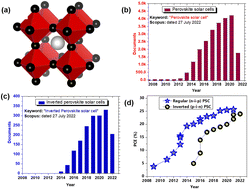High efficiency (>20%) and stable inverted perovskite solar cells: current progress and future challenges
Abstract
Perovskite solar cells (PSCs) are broadly assembled in two ways, i.e., regular (n–i–p) and inverted (p–i–n) structures. Inverted (p–i–n) PSC architecture has attracted attention due to its consistent operational stability and low-temperature synthesis methods. However, its power conversion efficiency is slightly inferior to that of regular (n–i–p) PSCs. The key challenges that still need to be addressed for inverted (p–i–n) PSCs include severe non-radiative recombination losses at the grain boundaries and interfacial trap-assisted recombination at the charge transporting layers/perovskite, which reduce the open circuit voltage (VOC) and fill factor (FF). Consequently, various strategies have been developed to overcome these drawbacks, which mainly include the passivation of traps at the interface, grain boundaries and bulk, adopting different hole and electron transport layers, and using unique perovskites combinations. The improvement in the performance of inverted (p–i–n) PSCs by adopting these approaches is attributed to their increased VOC, with their FFs confined to the range of 75% to 80%. Although, incorporating a modified material can augment the inverted (p–i–n) PSC performance yet the operational stability at high efficiencies is compromised. Additionally, for the commercial applications of this technology, key degradation factors such as moisture, light, and heat need to be considered, which have long plagued the long-term stability of perovskites. Thus, concerted efforts are being directed towards improving the stability of inverted (p–i–n) PSCs without affecting their efficiency and hence the performance of these devices. Presently, the efficiency of inverted PSCs has already surpassed 24%, which is gradually catching up to that of regular-structured (n–i–p) PSCs (25.7%). Therefore, a boost in the performance of these devices together with the establishment of device stability is imperative for future perspectives.



 Please wait while we load your content...
Please wait while we load your content...